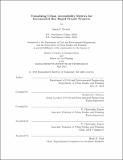| dc.contributor.advisor | Frederick P. Salvucci and P. Christopher Zegras. | en_US |
| dc.contributor.author | Stewart, Anson F. (Anson Forest) | en_US |
| dc.contributor.other | Massachusetts Institute of Technology. Department of Urban Studies and Planning. | en_US |
| dc.date.accessioned | 2014-12-08T18:08:53Z | |
| dc.date.available | 2014-12-08T18:08:53Z | |
| dc.date.copyright | 2014 | en_US |
| dc.date.issued | 2014 | en_US |
| dc.identifier.uri | http://hdl.handle.net/1721.1/92057 | |
| dc.description | Thesis: M.C.P., Massachusetts Institute of Technology, Department of Urban Studies and Planning, 2014. | en_US |
| dc.description | Thesis: S.M. in Transportation, Massachusetts Institute of Technology, Department of Urban Studies and Planning, 2014. | en_US |
| dc.description | This electronic version was submitted by the student author. The certified thesis is available in the Institute Archives and Special Collections. | en_US |
| dc.description | Cataloged from student-submitted PDF version of thesis. | en_US |
| dc.description | Includes bibliographical references (pages 135-144). | en_US |
| dc.description.abstract | As cities worldwide grow, their residents must be able to traverse urban space in order to access employment, social services, recreation, and other critical activities. Urban accessibility reflects the ease of such access with respect to locations within a city, and it is largely dependent on the city's land use and transport systems. A variety of urban accessibility metrics have been proposed to guide urban policy and planning, but they have not been implemented systematically. Better understood and more widely adopted accessibility measures could help guide complex land use and multimodal transportation planning processes toward more eective and equitable outcomes. Such measures represent a signicant departure from the facility, maintenance, and mobility priorities that dominate transportation planning today, opening possibilities for new approaches. In particular, a clearer focus on accessibility could help prioritize and inform the design of bus rapid transit (BRT) projects, which tend to include dierent potential streetscape, transport, and network improvement options across a wide range of geographic and temporal scales. This thesis aims to develop a participatory framework built on an open-source, web-based toolkit that transit advocates and planners can use to visualize how urban design and operational characteristics of dierent incremental BRT scenarios might affect access at a personal level and accessibility at a regional level. Such visualizations can encompass the interaction of these scenarios with pedestrian, local bus, and rail connectivity, as well as regional land use. Built on Open Trip Planner Analyst and other web-based civic engagement platforms, as well as open data such as transit information in the general transit feed specification (GTFS) format, this toolkit is applied to transit performance and accessibility for example projects in two contexts, Boston and Santiago de Chile. Focus groups with transit advocates and planners were conducted in these two settings to evaluate the proposed toolkit. Members of community-based transit advocacy organizations found the toolkit to be both understandable and able to represent some of their key concerns; professional planners thought the toolkit could help them better understand existing operations and proposed projects. These evaluations suggest that the participatory framework developed around this toolkit could be an eective platform for dialogue between planners and community organizations. By connecting individual perspectives on access with broader accessibility metrics, this framework has the potential to build political will for the adoption of equitable accessibility indicators as decision-making metrics. | en_US |
| dc.description.statementofresponsibility | by Anson F. Stewart. | en_US |
| dc.format.extent | 144 pages | en_US |
| dc.language.iso | eng | en_US |
| dc.publisher | Massachusetts Institute of Technology | en_US |
| dc.rights | M.I.T. theses are protected by copyright. They may be viewed from this source for any purpose, but reproduction or distribution in any format is prohibited without written permission. See provided URL for inquiries about permission. | en_US |
| dc.rights.uri | http://dspace.mit.edu/handle/1721.1/7582 | en_US |
| dc.subject | Urban Studies and Planning. | en_US |
| dc.title | Visualizing urban accessibility metrics for incremental bus rapid transit projects | en_US |
| dc.type | Thesis | en_US |
| dc.description.degree | M.C.P. | en_US |
| dc.description.degree | S.M. in Transportation | en_US |
| dc.contributor.department | Massachusetts Institute of Technology. Department of Urban Studies and Planning | |
| dc.identifier.oclc | 895661802 | en_US |
